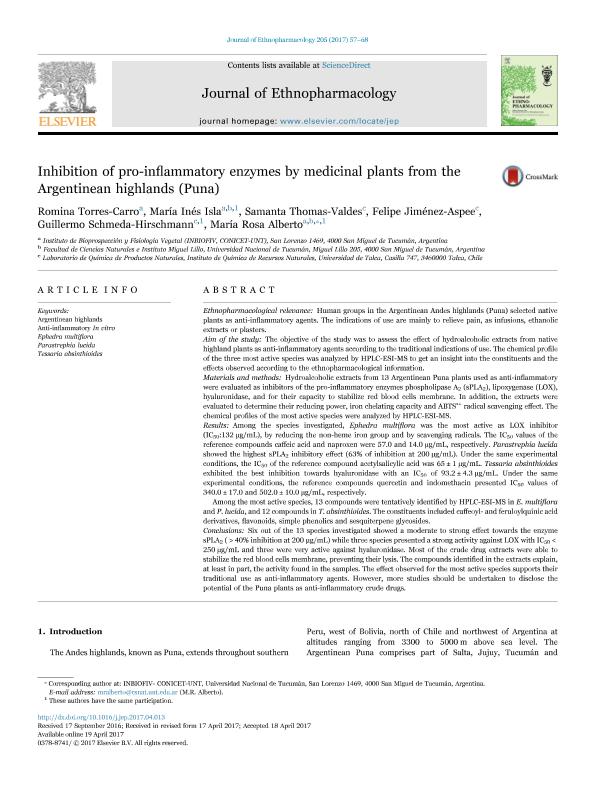Artículo
Inhibition of pro-inflammatory enzymes by medicinal plants from the Argentinean highlands (Puna)
Torres Carro, Romina ; Isla, Maria Ines
; Isla, Maria Ines ; Thomas Valdes, Samanta; Jiménez Aspee, Felipe; Schmeda Hirschmann, Guillermo; Alberto, Maria Rosa
; Thomas Valdes, Samanta; Jiménez Aspee, Felipe; Schmeda Hirschmann, Guillermo; Alberto, Maria Rosa
 ; Isla, Maria Ines
; Isla, Maria Ines ; Thomas Valdes, Samanta; Jiménez Aspee, Felipe; Schmeda Hirschmann, Guillermo; Alberto, Maria Rosa
; Thomas Valdes, Samanta; Jiménez Aspee, Felipe; Schmeda Hirschmann, Guillermo; Alberto, Maria Rosa
Fecha de publicación:
09/06/2017
Editorial:
Elsevier Ireland
Revista:
Journal of Ethnopharmacology
ISSN:
0378-8741
Idioma:
Inglés
Tipo de recurso:
Artículo publicado
Clasificación temática:
Resumen
Ethnopharmacological relevance Human groups in the Argentinean Andes highlands (Puna) selected native plants as anti-inflammatory agents. The indications of use are mainly to relieve pain, as infusions, ethanolic extracts or plasters. Aim of the study The objective of the study was to assess the effect of hydroalcoholic extracts from native highland plants as anti-inflammatory agents according to the traditional indications of use. The chemical profile of the three most active species was analyzed by HPLC-ESI-MS to get an insight into the constituents and the effects observed according to the ethnopharmacological information. Materials and methods Hydroalcoholic extracts from 13 Argentinean Puna plants used as anti-inflammatory were evaluated as inhibitors of the pro-inflammatory enzymes phospholipase A2 (sPLA2), lipoxygenase (LOX), hyaluronidase, and for their capacity to stabilize red blood cells membrane. In addition, the extracts were evaluated to determine their reducing power, iron chelating capacity and ABTS?+ radical scavenging effect. The chemical profiles of the most active species were analyzed by HPLC-ESI-MS. Results Among the species investigated, Ephedra multiflora was the most active as LOX inhibitor (IC50:132 µg/mL), by reducing the non-heme iron group and by scavenging radicals. The IC50 values of the reference compounds caffeic acid and naproxen were 57.0 and 14.0 µg/mL, respectively. Parastrephia lucida showed the highest sPLA2 inhibitory effect (63% of inhibition at 200 µg/mL). Under the same experimental conditions, the IC50 of the reference compound acetylsalicylic acid was 65±1 µg/mL. Tessaria absinthioides exhibited the best inhibition towards hyaluronidase with an IC50 of 93.2±4.3 µg/mL. Under the same experimental conditions, the reference compounds quercetin and indomethacin presented IC50 values of 340.0±17.0 and 502.0±10.0 µg/mL, respectively. Among the most active species, 13 compounds were tentatively identified by HPLC-ESI-MS in E. multiflora and P. lucida, and 12 compounds in T. absinthioides. The constituents included caffeoyl- and feruloylquinic acid derivatives, flavonoids, simple phenolics and sesquiterpene glycosides. Conclusions Six out of the 13 species investigated showed a moderate to strong effect towards the enzyme sPLA2 (>40% inhibition at 200 µg/mL) while three species presented a strong activity against LOX with IC50<250 µg/mL and three were very active against hyaluronidase. Most of the crude drug extracts were able to stabilize the red blood cells membrane, preventing their lysis. The compounds identified in the extracts explain, at least in part, the activity found in the samples. The effect observed for the most active species supports their traditional use as anti-inflammatory agents. However, more studies should be undertaken to disclose the potential of the Puna plants as anti-inflammatory crude drugs.
Archivos asociados
Licencia
Identificadores
Colecciones
Articulos(INQUINOA)
Articulos de INST.DE QUIMICA DEL NOROESTE
Articulos de INST.DE QUIMICA DEL NOROESTE
Citación
Torres Carro, Romina; Isla, Maria Ines; Thomas Valdes, Samanta; Jiménez Aspee, Felipe; Schmeda Hirschmann, Guillermo; et al.; Inhibition of pro-inflammatory enzymes by medicinal plants from the Argentinean highlands (Puna); Elsevier Ireland; Journal of Ethnopharmacology; 205; 9-6-2017; 57-68
Compartir
Altmétricas



